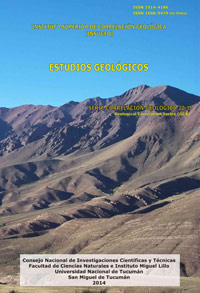Serie Correlación Geológica 30 (1)
Geología e interpretación petrológica de los granitos y pegmatitas de la Sierra de Mazán, La Rioja, Argentina
Alejandro J. Toselli | Juana N. Rossi | Miguel A. S. Basei
Descargar trabajo en formato PDFResumen
GEOLOGIA E INTERPRETACION PETROLOGICA DE LOS GRANITOS Y PEGMATITAS DE LA SIERRA DE MAZÁN, LA RIOJA, ARGENTINA. La sierra de Mazán se ubica al NE de la sierra de Velasco y al SO de la sierra de Ambato en el ámbito de las sierras Pampeanas Noroccidentales. Fallas regionales cenozoicas controlan la elongación N-S de la sierra y producen su basculamiento al oeste. Está formada por un basamento de edad cámbrica de bajo grado metamórfico, de afloramientos muy restringidos, conocido como Formación La Cébila, en el que intruye el granito porfiroide cordierítico
tipo S, fuertemente peraluminoso, de edad ordovícica, que constituye la mayor parte de la sierra de Mazán. En íntima asociación con el granito cordierítico se desarrollan dos fases félsicas tardías con afloramientos más restringidos: un leucogranito equigranular peraluminoso, que contiene vetas mineralizadas de cuarzo con casiterita y wolframita, y una fase pegmatítica bandeada, estéril, en la que alternan capas con megacristales de microlino pertítico, turmalina, cuarzo y moscovita, con capas equigranulares graníticas, ricas en albita y pobres en microclino, con cuarzo, moscovita y turmalina. En este nivel, las texturas gráficas y simplectíticas son muy comunes.
Todo el conjunto granítico muestra estrechas relaciones geológicas y por la continuidad de la deformación plástica que los afecta, se infiere que los eventos intrusivos son ordovícicos y están temporalmente poco separados entre sí.
Abstract
GEOLOGIC AND PETROLOGIC INTERPRETATION OF GRANITES AND PEGMATITES OF SIERRA DE MAZÁN, LA RIOJA,
ARGENTINA. The Sierra de Mazán is located in Northern Sierras Pampeanas, nearby the Sierra de Velasco and the Sierra de Ambato. The Sierra is tilted to the west by Cenozoic regional faults, which control the NS elongation. A low metamorphic basement is represented by the Cambrian La Cébila Formation which is intruded by Lower Ordovician, strongly peraluminous S-type porphyritic cordierite-bearing granite, that makes up most of the Sierra de Mazán. Two minor felsic phases are close related with the S-type granite: The one is an equigranular peraluminous leucogranite that contains mineralized quartz veins with cassiterite and wolframite, known as La Quebrada Granite. The other barren felsic phase shows a textural layering defined by alternating bands of pegmatite, composed of megacrysts of perthite-microcline. Quartz, muscovite, minor albite and tourmaline, make up the remainder of the coarse layer. An alternated medium-grained layer, display an equigranular texture composed of quartz, albite, muscovite, scarce microcline and tourmaline. Graphic and symplectitic textures are common in this layer.
The cordierite-granite and its two felsic phases display plastic deformation, and are genetically interpretated as synchronous and continuous during the Ordovician times.
The magmatic history of different granitic phases is interpreted following these steps: 1) An S-type granitic melt originated deep in the crust by incongruent partial melting of fluid – absent aluminous greywackes. These conditions
allowed the rise and crystallization of magma and its location at shallow levels. 2) The remaining melt after the principal crystallization consisted of a felsic silicate melt with some S and W complexes. 3) The water rich last melt produced a layered barren pegmatite rich in boron.
The geochemistry of the different stages from the cordierite granite to pegmatite phases suggest, an evolution
by fractional crystallization of cordierite granite, where the major oxide elements Fe, Mg, and Ca decrease while the SiO2 increases. Ba, Sr, Zr and Ti trace elements are strongly depleted in the pegmatitic melt.
The fractionation of zircon, monazite and apatite produced REE depletion and a strong negative Eu anomaly in the residual pegmatitic melt, in equilibrium with a boron-rich aqueous phase. This process produced the tetrad effect displayed by the REE patterns.






